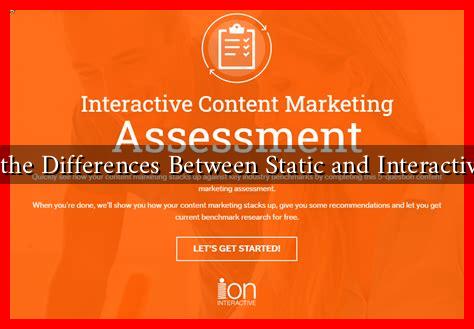-
Table of Contents
What Are the Differences Between Static and Interactive Content?
In the digital age, content is king. However, not all content is created equal. Two primary types of content that marketers and content creators often utilize are static and interactive content. Understanding the differences between these two forms can significantly impact engagement, conversion rates, and overall user experience. This article delves into the characteristics, advantages, and examples of static and interactive content, providing valuable insights for businesses and content creators alike.
Defining Static Content
Static content refers to any content that does not change or adapt based on user interaction. It is typically pre-created and delivered to the user in a fixed format. Common examples of static content include:
- Text-based articles and blog posts
- Images and infographics
- PDF documents
- Videos that do not allow user interaction
Static content is often easier to produce and can be highly effective for delivering information quickly and efficiently. However, it lacks the engagement factor that many users seek in today’s interactive digital landscape.
Understanding Interactive Content
In contrast, interactive content is designed to engage users actively. This type of content encourages participation and often adapts based on user input. Examples of interactive content include:
- Quizzes and polls
- Interactive infographics
- Surveys and feedback forms
- Games and simulations
- Calculators and configurators
Interactive content not only captures attention but also fosters a deeper connection with the audience, making it a powerful tool for engagement and retention.
Key Differences Between Static and Interactive Content
While both static and interactive content serve important roles in digital marketing, they differ significantly in several aspects:
- User Engagement: Interactive content typically results in higher engagement rates. According to a study by HubSpot, interactive content can generate up to 2 times more conversions than static content.
- Information Delivery: Static content is straightforward and effective for delivering information quickly, while interactive content allows for a more personalized experience, adapting to user preferences and responses.
- Production Complexity: Creating static content is generally less resource-intensive than interactive content, which often requires more time, technical skills, and creativity to develop.
- Analytics and Insights: Interactive content provides richer data on user behavior, allowing marketers to gain insights into preferences and engagement levels, which can inform future strategies.
Case Studies: Success Stories of Static vs. Interactive Content
To illustrate the effectiveness of both content types, consider the following case studies:
- Static Content Success: A well-known travel blog utilized static content in the form of detailed guides and articles about various destinations. This approach helped them rank high on search engines, driving significant organic traffic and establishing authority in the travel niche.
- Interactive Content Success: A leading skincare brand launched an interactive quiz that helped users identify their skin type and recommended products accordingly. This initiative not only increased user engagement but also resulted in a 30% increase in sales from quiz participants.
Conclusion: Choosing the Right Content for Your Strategy
In conclusion, both static and interactive content have their unique advantages and serve different purposes in a comprehensive content strategy. Static content is ideal for delivering straightforward information and establishing authority, while interactive content excels in engaging users and fostering deeper connections. By understanding the differences between these two types of content, businesses can tailor their strategies to maximize engagement, drive conversions, and enhance the overall user experience.
Ultimately, the best approach may involve a combination of both static and interactive content, allowing brands to cater to diverse audience preferences and achieve their marketing goals effectively.


